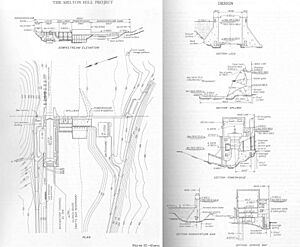Melton Hill Dam facts for kids
Quick facts for kids Melton Hill Dam |
|
|---|---|

Melton Hill Lock and Dam. View is downriver to the west. The Tennessee State Route 95 bridge can be seen downriver.
|
|
| Official name | Melton Hill Dam |
| Location | Roane County and Loudon County, Tennessee, United States |
| Coordinates | 35°53′7″N 84°18′0″W / 35.88528°N 84.30000°W |
| Construction began | September 6, 1960 |
| Opening date | May 1, 1963 |
| Operator(s) | Tennessee Valley Authority |
| Dam and spillways | |
| Impounds | Clinch River |
| Height | 103 feet (31 m) |
| Length | 1,020 feet (310 m) |
| Reservoir | |
| Creates | Melton Hill Lake |
| Power station | |
| Turbines | 2 |
| Installed capacity | 72 MW |
Melton Hill Dam is a large hydroelectric dam located on the Clinch River. It is found just south of Oak Ridge, Tennessee, in the United States. The dam was built by the Tennessee Valley Authority (TVA) in the early 1960s.
Its main jobs are to create electricity and help boats travel further up the Clinch River. The dam forms a lake called Melton Hill Lake, which covers about 5,470 acres. It is special because it's the only TVA dam on a smaller river that has a navigation lock for boats. In 2017, the dam was recognized as an important historic place.
The dam got its name from a nearby hill called Copper Ridge. Back in 1884, a survey team set up a special marker there.
Contents
Where is Melton Hill Dam Located?
The Clinch River starts in southwestern Virginia and flows for about 300 miles. It goes through the hills of northeastern Tennessee. Finally, it empties into the Tennessee River near Kingston.
Melton Hill Dam is about 23 miles upstream from where the Clinch River joins the Tennessee River. It stretches across the border between Roane and Loudon counties. The water below Melton Hill Dam is part of Watts Bar Lake. This larger lake is on the main Tennessee River.
How Big is Melton Hill Dam?
Melton Hill is a concrete dam designed to hold back water. It can produce 79 megawatts of electric power. The dam stands 103 feet (31 meters) tall. It stretches 1,020 feet (311 meters) across the Clinch River.
The dam has three spillway gates. These gates can release a lot of water, up to 118,000 cubic feet per second.
Melton Hill Lake offers almost 193 miles of shoreline. It has 5,470 acres of water. This makes it a great place for boating and other water activities. The lake touches parts of Loudon, Roane, Anderson, and Knox counties.
The lake stretches 56 miles up the Clinch River. It goes all the way to the base of Norris Dam. Boats can travel about 38 miles from Melton Hill Dam up to Clinton.
Melton Hill Dam is unique among TVA dams on smaller rivers. It has a special navigation lock. This lock helps boats move between different water levels. The lock is 75 feet wide and 400 feet long. It can raise or lower boats 60 feet. This allows vessels to travel between Melton Hill Lake and Watts Bar Lake.
Building the Dam
The United States Army Corps of Engineers first thought about building a dam at Melton Hill in the 1920s. Later, the Tennessee Valley Authority (TVA) also studied the area in the late 1930s. TVA officially suggested the Melton Hill project in 1957.
After several years, Congress agreed to provide money for the dam. President Dwight D. Eisenhower signed the funding bill on September 2, 1960. TVA started building the dam just a few days later, on September 6, 1960.
Building the dam and its lake meant buying a lot of land. About 6,182 acres of land were needed. Some of this land was owned by the United States Atomic Energy Commission. They agreed to trade their land for other land near Watts Bar Lake.
The project also required moving 89 families. About 12.5 miles of roads had to be rebuilt. A special experimental farm also needed to be moved. TVA bought new land for the farm and helped replant it.
Melton Hill Dam was finished on May 1, 1963, when its gates were closed. The first generator started making electricity on July 3, 1964. The second generator began working on November 11, 1964. The dam's lock was designed by the Army Corps of Engineers. It was made to be larger than typical TVA locks. This allows it to hold several barges at once. The lock opened for boats on June 10, 1963.


